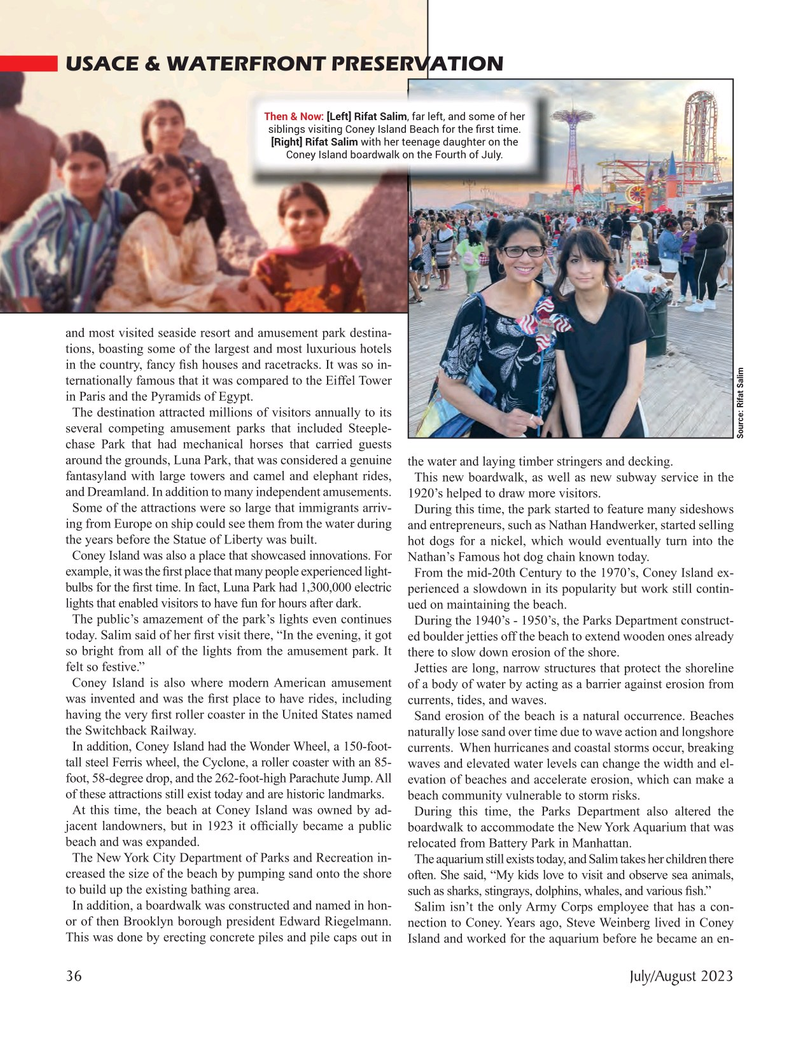
Page 36: of Marine Technology Magazine (July 2023)
Read this page in Pdf, Flash or Html5 edition of July 2023 Marine Technology Magazine
USACE & WATERFRONT PRESERVATION
Then & Now: [Left] Rifat Salim, far left, and some of her siblings visiting Coney Island Beach for the ? rst time. [Right] Rifat Salim with her teenage daughter on the
Coney Island boardwalk on the Fourth of July. and most visited seaside resort and amusement park destina- tions, boasting some of the largest and most luxurious hotels in the country, fancy ? sh houses and racetracks. It was so in- ternationally famous that it was compared to the Eiffel Tower in Paris and the Pyramids of Egypt.
The destination attracted millions of visitors annually to its several competing amusement parks that included Steeple-
Source: Rifat Salim chase Park that had mechanical horses that carried guests around the grounds, Luna Park, that was considered a genuine the water and laying timber stringers and decking. fantasyland with large towers and camel and elephant rides, This new boardwalk, as well as new subway service in the and Dreamland. In addition to many independent amusements. 1920’s helped to draw more visitors.
Some of the attractions were so large that immigrants arriv- During this time, the park started to feature many sideshows ing from Europe on ship could see them from the water during and entrepreneurs, such as Nathan Handwerker, started selling the years before the Statue of Liberty was built. hot dogs for a nickel, which would eventually turn into the
Coney Island was also a place that showcased innovations. For Nathan’s Famous hot dog chain known today.
example, it was the ? rst place that many people experienced light- From the mid-20th Century to the 1970’s, Coney Island ex- bulbs for the ? rst time. In fact, Luna Park had 1,300,000 electric perienced a slowdown in its popularity but work still contin- lights that enabled visitors to have fun for hours after dark. ued on maintaining the beach.
The public’s amazement of the park’s lights even continues During the 1940’s - 1950’s, the Parks Department construct- today. Salim said of her ? rst visit there, “In the evening, it got ed boulder jetties off the beach to extend wooden ones already so bright from all of the lights from the amusement park. It there to slow down erosion of the shore. felt so festive.” Jetties are long, narrow structures that protect the shoreline
Coney Island is also where modern American amusement of a body of water by acting as a barrier against erosion from was invented and was the ? rst place to have rides, including currents, tides, and waves. having the very ? rst roller coaster in the United States named Sand erosion of the beach is a natural occurrence. Beaches the Switchback Railway. naturally lose sand over time due to wave action and longshore
In addition, Coney Island had the Wonder Wheel, a 150-foot- currents. When hurricanes and coastal storms occur, breaking tall steel Ferris wheel, the Cyclone, a roller coaster with an 85- waves and elevated water levels can change the width and el- foot, 58-degree drop, and the 262-foot-high Parachute Jump. All evation of beaches and accelerate erosion, which can make a of these attractions still exist today and are historic landmarks. beach community vulnerable to storm risks.
At this time, the beach at Coney Island was owned by ad- During this time, the Parks Department also altered the jacent landowners, but in 1923 it of? cially became a public boardwalk to accommodate the New York Aquarium that was beach and was expanded. relocated from Battery Park in Manhattan.
The New York City Department of Parks and Recreation in- The aquarium still exists today, and Salim takes her children there creased the size of the beach by pumping sand onto the shore often. She said, “My kids love to visit and observe sea animals, to build up the existing bathing area. such as sharks, stingrays, dolphins, whales, and various ? sh.”
In addition, a boardwalk was constructed and named in hon- Salim isn’t the only Army Corps employee that has a con- or of then Brooklyn borough president Edward Riegelmann. nection to Coney. Years ago, Steve Weinberg lived in Coney
This was done by erecting concrete piles and pile caps out in Island and worked for the aquarium before he became an en- 36 July/August 2023
MTR #5 (34-48).indd 36 7/27/2023 8:21:47 AM

 35
35

 37
37
